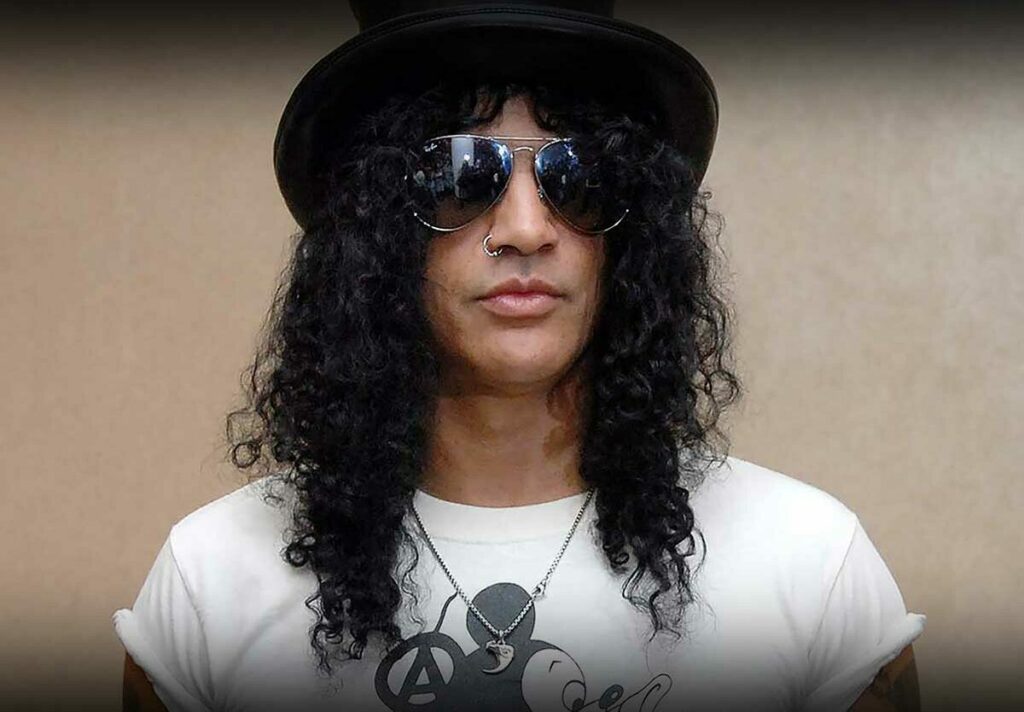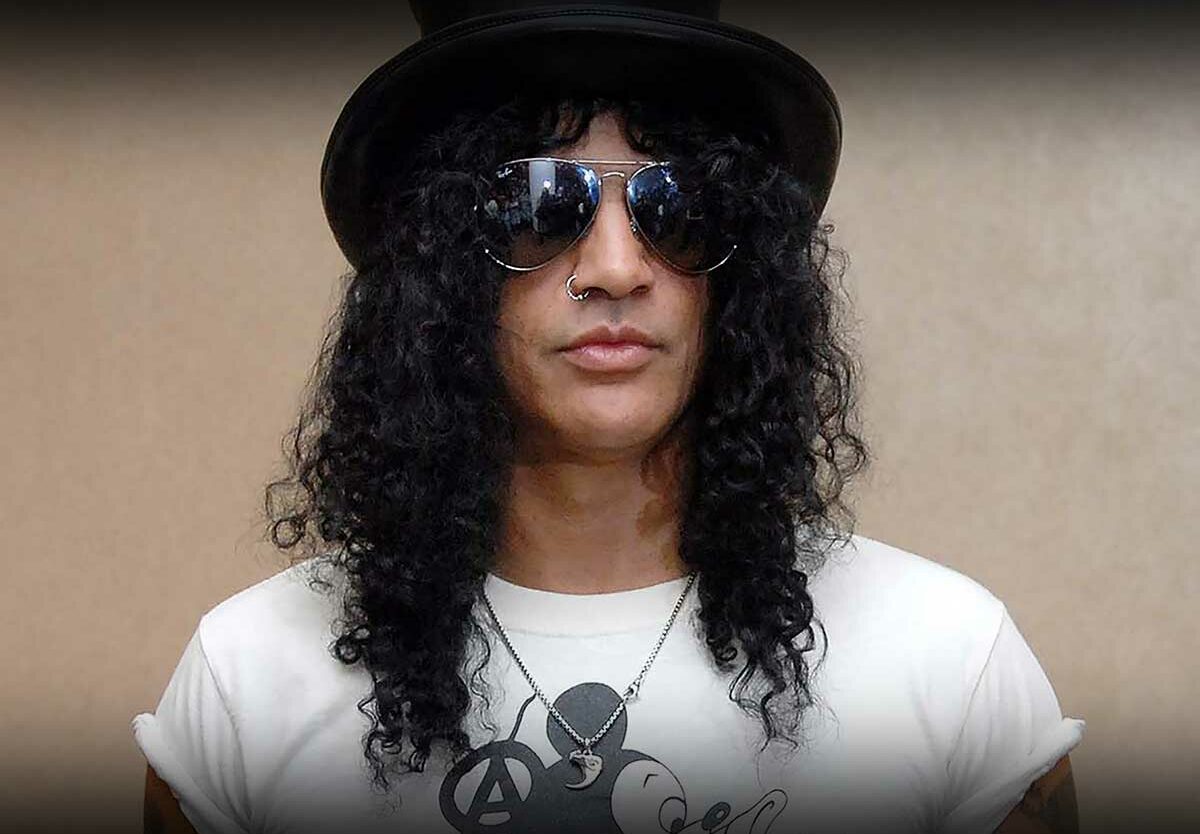
Slash Recollects His First Guitar: A Journey Down Memory Lane
When the image of legendary guitarist Slash surfaces in one’s mind, it’s inextricably linked with his trusted Gibson Les Paul, almost as if it were a natural extension of his body. Known for his signature top hat, copious dark curls, and the enigmatic presence he emanates on stage, Slash, in reality, is as synonymous with his instrument as the legendary riffs he’s created with it. However, the odyssey to his Gibson Les Paul was not as straightforward or as immediate as some might presume. The genesis of this journey was a humble one-string, Spanish acoustic guitar.
Watch the full exclusive interview with Slash here:
“My first guitar that I ever got was a one-string, Spanish acoustic guitar,” Slash confided during a candid conversation with All Axess. Though rudimentary and far from the standard six-stringed guitar that beginners typically start with, this instrument was the seed that began to germinate a life-long relationship with music. A relationship that would soon grow and evolve, transcending from an innocent flirtation into a deep, passionate love affair that transformed Saul Hudson, the wide-eyed youngster, into Slash, the global rock icon.
Born in 1965 as Saul Hudson, Slash was an entity that gravitated towards music from a very tender age. His early years were spent in the United Kingdom, where he was exposed to a diverse variety of music, but it wasn’t until his migration to Los Angeles that he truly found his calling. The city of angels, renowned for its vibrant music scene, left an indelible imprint on him. This was a city that had music reverberating in its veins, and it’s here that the future lead guitarist of Guns N’ Roses would not only learn to fly but truly soar.
The one-string guitar, while unconventional, proved to be an instrumental stepping stone in Slash’s musical education. With only one string to fret and strum, he was compelled to focus on individual notes, on understanding the profound connection between each pluck and the sound it resonated. It was during this phase that Slash began fine-tuning his skills, learning to weave melodies from a single string, and nurturing a deep-seated respect for the very essence of music.
When Slash eventually equipped his Spanish acoustic guitar with the remaining five strings, he began experimenting with an array of chords and riffs, opening the door to an endless sonic realm that six strings could offer. His evolution as a guitarist was neither swift nor spontaneous, but a gradual progression that was a product of innumerable hours dedicated to plucking and experimenting with his acoustic instrument.
Slash’s first rendezvous with the Gibson Les Paul, the instrument that would soon become an integral part of his identity, didn’t occur until he was in his late teens. This encounter was not just an upgrade from his first instrument; it was akin to a transformative revelation. The Les Paul, with its dual-humbucker configuration and solid mahogany body, provided Slash with the tools to fabricate a sound that was rich, full-bodied, and laden with sustain – elements that would soon morph into his signature sound.
As the years rolled by, Slash’s style metamorphosed from an unrefined, raw sound into a polished, distinctive sonic signature that is immediately identifiable. His solos, distinguished by their melodic narratives, the frequent use of pentatonic scales, and soul-stirring bends, never fail to leave a listener mesmerized. His eclectic mix of blues, rock, and hard metal became a defining element in shaping the sound of Guns N’ Roses, the band that catapulted him to global fame in the mid-to-late 1980s.
In spite of Guns N’ Roses’ eventual dissolution in the late ’90s, Slash remained an inexhaustible force in the music world. He went on to form the supergroup Velvet Revolver, collaborated with an array of artists across various genres, and produced a series of successful solo albums. Regardless of the venture, Slash’s guitar playing remains as unique and distinctive as ever.
Despite the dizzying heights of success and fame, Slash has always been grounded, never forgetting his humble beginnings. His first guitar, the one-string Spanish acoustic, holds a special place in his heart, a nostalgic memento of his musical journey. It’s a journey that began with a curious youngster and a single-stringed instrument, evolving over time to mold one of the most influential guitarists of his generation.
In the present day, Slash’s name is often brought up in conjunction with Gibson, having produced his own signature Les Paul models. But his voyage began with a modest single string on an acoustic guitar. His story stands as a testament to the power of perseverance, of an undying passion for music, and of the incredible journeys that can be embarked upon when a young mind’s curiosity is ignited by the strum of a guitar string.
While many remember Slash for his signature solos, his electrifying live performances, or his iconic style, it’s crucial to remember the genesis of it all. After all, it was the one-string, Spanish acoustic guitar that sparked the flame in a young Slash, a flame that continues to burn with an undying vigor, illuminating the world of rock ‘n’ roll.
When he finally did learn to restring his guitar completely, he began experimenting with chords and riffs, exploring the infinite sonic landscape that six strings could offer. His progression as a guitarist was steady, the product of countless hours spent strumming and experimenting with the acoustic instrument.
Slash’s first encounter with the Gibson Les Paul, the instrument that would come to define his sound, didn’t happen until his late teens. It was not just a step up from his first instrument; it was a quantum leap. The Les Paul’s dual-humbucker configuration and solid mahogany body gave Slash the ability to produce the rich, full-bodied, and sustain-heavy sound that would become his trademark.
Over the years, Slash’s style evolved from a raw, unpolished sound to a refined, distinctive sonic signature that is instantly recognizable. His solos are characterized by their melodic approach, pentatonic scales, and blistering bends. His unique mix of blues, rock, and hard metal helped define the sound of Guns N’ Roses, the band that catapulted him into the spotlight in the mid-to-late 1980s.
After the eventual dissolution of Guns N’ Roses in the late ’90s, Slash continued to contribute significantly to the world of music. He formed the supergroup Velvet Revolver, collaborated with a multitude of artists across various genres, and even produced a number of successful solo albums. Regardless of the project, his guitar playing remains as distinctive as ever.
And despite the success and fame, Slash has never forgotten his humble beginnings. His first guitar, the one-string Spanish acoustic, continues to hold a special place in his heart. It stands as a testament to his musical journey, from a curious youngster with a single-stringed instrument to one of the most influential guitarists of his generation.


